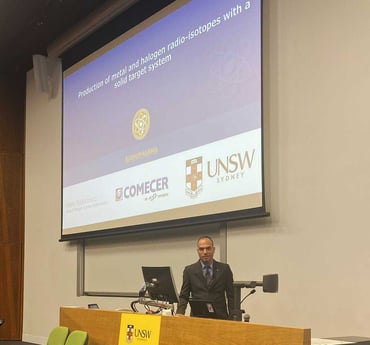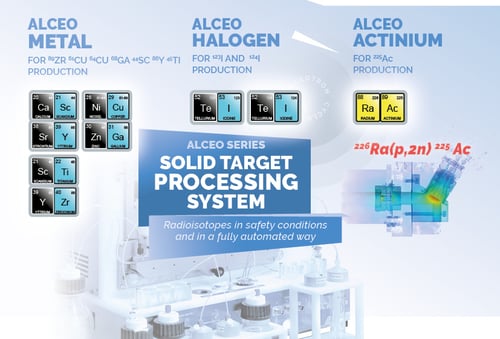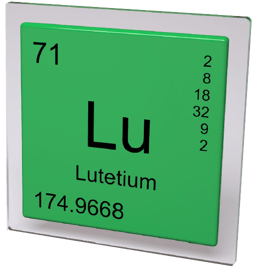Radiopharma - Nuclear Medicine
From radioisotopes to radiotherapy
How to produce radioisotopes for Nuclear Medicine
What is an element?
A chemical element is a chemical substance that cannot be broken down into other substances. The basic particle that constitutes a chemical element is the atom, and chemical elements are distinguished from each other by the number of protons in the nuclei of their atoms. This is in contrast to chemical compounds and mixtures.
There are now 118 known elements. In this context, "known" means observed well enough, even from just a few decay products, to have been differentiated from other elements.
What's the difference between isotopes and radioisotopes?
An isotope is an atom, of any chemical element, that maintains the same atomic number (Z) but different mass number (A) and therefore different atomic mass (M).
Isotopes are divided into stable isotopes (about 252) and nonstable or radioactive isotopes (about 3000 known and another 4000 assumed from theoretical calculations up to element 118). Radioisotopes are radioactive isotopes, that is, radionuclides of the same chemical element.
The radionuclides (radioisotopes) have countless uses in science (radiochemistry and nuclear chemistry):
- to date fossils, rocks, archaeological finds (14C)
- in biochemistry and toxicology, in the appropriate chemical form (labeled compounds), to study the effects and transformations a given molecule undergoes through exposure to low concentrations of chemical elements and compounds;
- in the biomedical field, radiation emitted by numerous radionuclides (in the form of radiotracers or radiopharmaceuticals) has proven useful to diagnose a variety of diseases and/or destroying cancer cells in nuclear medicine.
What is nuclear medicine?
Nuclear medicine is a branch of medicine that uses radioactive isotope-labeled drugs (radiopharmaceuticals) for diagnostic, therapeutic and biomedical research purposes. Diagnostic methods consist of studying the fixation of a radionuclide bound to a carrier molecule, which "mimics" the metabolic activity of a tissue or attaches to it through interaction with appropriate receptors, such as using a monoclonal antibody that binds a radionuclide to it. Single Photon Emission Computed Tomography or SPECT and Positron Emission Tomography or PET scans are the two most common imaging modalities in nuclear medicine.
The main types of radiopharmaceuticals
- Radionuclides used as such, in different chemical formulations: 99mTc pertechnetate; 131I sodium iodide; 123I sodium iodide; 111In chloride; 67Ga citrate;
- Chemical molecules with different biological behavior, supplied in the form of kits in lyophilized vials already labeled or more frequently to be labeled with a radionuclide, usually 99mTc;
- Monoclonal antibodies or fragments thereof, already labeled or to be labeled generally with 111In chloride, 99mTc, 131I;
- Radiopharmaceuticals such as 18FDG that use short-lived β+-emitting radionuclides produced by cyclotron and used for PET (18F, 13N, 11C, 15O).
Other commonly used radionuclides are: rhenium-186, yttrium-90, lutetium-177 and erbium-169 for various radiometabolic therapies.
Comecer IRIS Radiopharmaceutical Multidose Injector can now inject therapeutic radiopharmaceuticals based on 177Lu for Radionuclide Therapy
Gallium and radiopharmacy
Gallium is used in both diagnostic and therapeutic areas of human medicine. Isotopes 67Ga and 72Ga are used as radioactive markers in the diagnosis of certain cancers, such as lymphomas, because of gallium's predisposition to accumulate more at sites of active proliferation.
68Ga with a half-life of only 68 minutes, inconvenient for transport, is extracted and used for certain positron emission tomography nuclear medicine diagnostic procedures, where the radioisotope's relatively short half-life and emission of positrons for creation of 3-dimensional PET scans, are useful. 68Ga can be produced with a cyclotron (solid or liquid target) or a generator.
A germanium-68/gallium-68 generator is a device used to extract the positron-emitting isotope 68Ga of gallium from a source of decaying germanium-68. The parent isotope 68Ge has a half-life of 271 days and can be easily utilized for in-hospital production of generator produced 68Ga.
Germanium-68/gallium-68 generator functioning: The stationary phase is either metal-free or alumina, TiO2 or SnO2, onto which germanium-68 is adsorbed. The use of metal-free columns allows direct labeling of 68Ga without prepurification, hence making production of gallium-68-radiolabeled compounds more convenient. The mobile phase is a solvent able to elute (wash out) gallium-68 (III) (68Ga3+) after it has been produced by electron capture decay from the immobilized (absorbed) germanium-68. Currently, such 68Ga (III) is easily eluted with a few mL of 0.05 M, 0.1 M or 1.0 M hydrochloric acid from generators using metal-free tin dioxide or titanium dioxide adsorbents, respectively, within 1 to 2 minutes. With generators of tin dioxide and titanium dioxide-based adsorbents, there once remained more than an hour of pharmaceutical preparation to attach the gallium-68 (III) as a tracer to the pharmaceutical molecules DOTATOC or DOTA-TATE, so that the total preparation time for the resulting radiopharmaceutical was typically longer than the 68Ga isotope half-life. This fact required that these radiopharmaceuticals be made on-site in most cases, and the on-site generator was required to minimize the time losses; unless there is the possibility to produce big amount of 68Ga, for example with a solid target.
How are radioisotopes produced?
Radioisotopes can be produced in cyclotrons, nuclear reactors, or radioisotope generators. Accelerator driven systems (ADSs) can also be used for production of radioisotopes as well as fissile fuel breeding and energy generation.
A cyclotron, or circular accelerator, is a machine used to accelerate beams of electrically charged particles (usually light ions) using a high-frequency, high-voltage alternating current in association with a perpendicular magnetic field.
Modern isotope production systems often consist of a compact cyclotron for the production of H- ions with an energy between 10 and 30 MeV; radioisotopes produced for medical applications are used in nuclear medicine to make diagnoses.
Cyclotrons are beginning to be used commercially and industrially for specific applications, especially in medicine for radioisotope production and cancer therapy.
Today the number of small cyclotrons, dedicated to commercial and medical use, is growing rapidly. The list of manufacturing companies contains many new names such as IBA, ACSI, GE, Oxford Instruments etc. Many hospitals today appear to be ready to install their own cyclotron. All of this equipment is optimized for its specific use and has been constructed in the simplest manner and made user-friendly for operators.
Solid target processing system
A Solid target processing system is an integrated system designed for radioisotope production by irradiating a solid target.
Why is Solid Target used?
• High yield of radionuclide production;
• Absence of the impurities in the final product;
• Reduced target production costs.
Want to learn more?
Read the presentation on the production of metal and halogen radioisotopes with a solid target system

ALCEO
Solid Target Processing System
ALCEO is a fully automated solid target processing system for the production of radionuclides used in radiopharma. The radionuclides produced are available in a form suitable for radiopharmaceutical synthesis. The integrated system allows all the operations to be carried out without the manual intervention of operators.
It is presented as a machine that can be configured according to various parameters, such as:
• the type of isotope
• the specific isotopes to be produced
• use of “disposable cassette”
• possibility of upgrade
Watch now the on demand webinar:
How to push a medical cyclotron to produce innovative isotopes: solid target is the solution
ALCEO Series is a family of configurable machines based on various parameters such as:
- the type of isotope
- the specific radioisotopes to be produced
- use of “disposable cassette”
- the type of process chosen for the production of several radioisotopes:
The radioisotopes that Alceo Series can produce:
61Cu, 64Cu, 89Zr, 124I, 123I, 68Ga, 44Sc, 86Y and 45Ti

How about Copper-64?
Copper-64 (64Cu) is an attractive radionuclide for nuclear medical imaging. This radionuclide decays with low energy positron emission (β+ 17.6%, Eavg = 653 keV) and intermediate half-life (t1/2 = 12.7 h). 64Cu is amenable for labelling both short (minutes) and long (hours/days) incubating biological vectors and is exemplified by the many reports of 64Cu labelled small molecule, peptides, proteins and nanoparticles. Clinical studies with 64Cu have also progressed significantly in the past two decades.
Discover how we can obtain high-purity [64Cu]CuCl2 via a cassette-based automated separation method using a one column approach implemented on the Taddeo-PRF chemistry platform.
The Role of Actinium in Radiopharma
Due to its clinical significance, Targeted Alpha Therapy (TAT) has attracted a special attention. Actinium-225 (225Ac, α = 100%, T1/2 = 9.92 days) is a promising radionuclide usable for TAT. However, its production on a wide scale is in the development stage, while the global demand has increased. Compared to the worldwide demand of 225Ac, the amount produced via depleted thorium-229 sources is minimal, making it an expensive radionuclide. Alternative production routes (including cyclotrons, reactors and high-energy linear accelerators) are therefore widely desired.
The Role of Iodine in Radiopharma
The handling and manipulation of a wide variety of unsealed sources in nuclear medicine centers and radioisotope production centers may cause significant internal exposure for workers.
Iodine and its isotopes are considered one of the most frequently used radionuclides for the diagnosis and radiotherapy of thyroid diseases.
Only one of the thirty-seven known isotopes of iodine, iodine-127, occurs in nature. The others are radioactive. The half-lives of the other iodine radioisotopes are only a few days longer. Some of them are utilized in medicine in relation to the thyroid gland, which is where the body stores and concentrates the iodine that enters. Iodine-123 has a half-life of thirteen hours and decays by electron capture to tellurium-123, emitting gamma radiation; it is used in nuclear medicine imaging, including single photon emission computed tomography (SPECT) and X-ray computed tomography (X-Ray CT) scans.
-

Any questions or doubts?
We are here to help!
Our Radiopharma expert can contact you to talk about your needs and the best approach to address them.
We invite you to schedule a time slot and day of the week that is most convenient for you.
We will send you a follow-up email to confirm the details.

